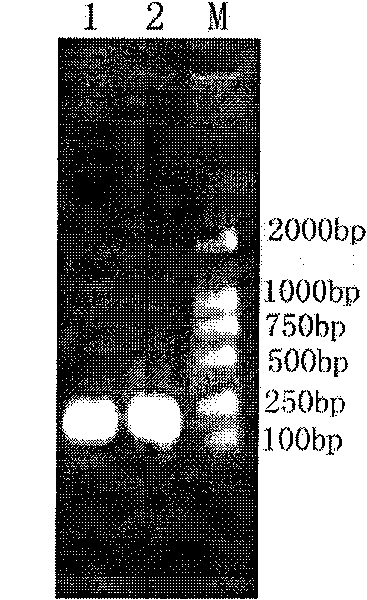Prawn white spot syndrome virus VP37p polypeptide fragment and application thereof
A technology for shrimp and active peptides, applied in the direction of viral peptides, applications, antiviral agents, etc., can solve the problem of less understanding of the molecular level of the virus
- Summary
- Abstract
- Description
- Claims
- Application Information
AI Technical Summary
Problems solved by technology
Method used
Image
Examples
Embodiment 1
[0046] Example 1 Cloning and sequencing of WSV254 gene fragments
[0047] Using WSSV genomic DNA as a template, a partial fragment (133bp-299bp) of WSV254 gene was amplified with primers P1 and P2.
[0048] P1: 5'-AGA CTCGAG ATGAGACGTCAAGTTG-3';
[0049] P2: 5'-GAG AAGCTT GTCAATGAGGGAGTTA-3';
[0050] The underlined part CTCGAG is the Xhol restriction site, AAGCTT is the Hind restriction site, and the PCR reaction conditions are:
[0051] 94°C 10 minutes
[0052] 94°C for 30 seconds
[0053] 44.2°C for 30 seconds
[0054] 72°C for 1 minute (8 cycles)
[0055] 94°C for 30 seconds
[0056] 51.7°C for 30 seconds
[0057] 72°C for 1 minute (30 cycles)
[0058] 72°C 10 minutes
[0059] After the amplified fragment was purified by agarose gel electrophoresis, it was cloned into the prokaryotic expression plasmid vector pBADgA to obtain the recombinant expression plasmid pBADgA-rVP37p, and then sequenced. The partial gene sequence of WSV254 obtained by sequencing is show...
Embodiment 2
[0062] Example 2 Expression and Purification of Recombinant VP37p Fragment
[0063] The recombinant expression plasmid pBADgA-rVP37p containing the WSV254 gene was transformed into E. coli TOP 10, and the positive clones were selected and cultured in LB medium containing 100 mg / L ampicillin at 37°C until OD 600 When = 0.6, L-arabinose was added to a final concentration of 0.2%, and the cells were collected after induction at 37°C for 5 hours. Add ice-cold lysis buffer (1×PBS, 10mM NaHPO 4 , 140mM NaCl, 2.7mM KCL, 1.8mM KH 2 HPO 4 ), ultrasonically lyse the bacteria (300W×10s×10 times), centrifuge at 15,000rpm at 4°C for 20min, install a tweezer column (Ni-nitriloacetic acid resins), and wash off with 5-10 column bed volumes of washing buffer (1×PBS). Miscellaneous proteins; elution buffer (50mM Tris-HCL, 100mM, imidazole, pH 8.0) to elute the target protein. The molecular weight of the purified protein was identified by SDS-PAGE to be about 12.09kD, and the purity was over...
Embodiment 3
[0066] Example 3 Binding activity of recombinant VP37p fragments to shrimp cells
[0067] Select well-adhered cells and place them in pre-cooling at 4°C for 1 hour, discard the medium, carefully wash twice with cold PBS buffer, add fluorescein-labeled VP37p, combine at 4°C for 2 hours, and then carefully wash with PBS buffer After washing twice, DAPI stained the nuclei, and observed the results directly under a fluorescent microscope (Olympus). At the same time, unlabeled VP37p and FITC-labeled bovine serum albumin (BSA) were used as blank controls.
[0068] After FITC-labeled VP37p interacts with adherent cells, green fluorescence can be seen under a fluorescent microscope, and DAPI-stained blue nuclei can be observed in the same field of view. After the two fields of view are superimposed, it can be seen that the green fluorescence is just superimposed with the blue fluorescence, while the control only The blue fluorescence of cell nucleus staining was observed, but the gre...
PUM
 Login to View More
Login to View More Abstract
Description
Claims
Application Information
 Login to View More
Login to View More - R&D
- Intellectual Property
- Life Sciences
- Materials
- Tech Scout
- Unparalleled Data Quality
- Higher Quality Content
- 60% Fewer Hallucinations
Browse by: Latest US Patents, China's latest patents, Technical Efficacy Thesaurus, Application Domain, Technology Topic, Popular Technical Reports.
© 2025 PatSnap. All rights reserved.Legal|Privacy policy|Modern Slavery Act Transparency Statement|Sitemap|About US| Contact US: help@patsnap.com



